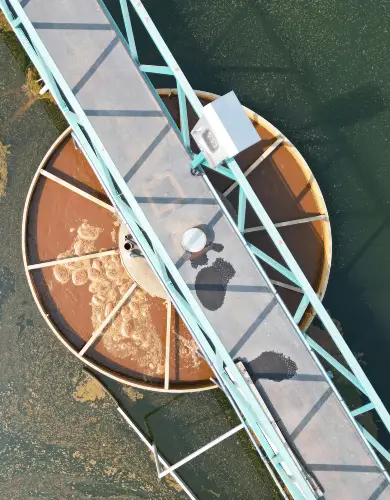What are carbon credits?
The Kyoto agreement introduced the idea of carbon credits to make it easier for emitters of greenhouse gases to fund environmental projects that positively impact the atmosphere and the wider environment.
Countries across the globe are working to achieve a state of carbon neutrality by 2050, where all greenhouse gas emissions are balanced by activities that remove these harmful gases.
In many industrial activities, greenhouse gas emissions are unavoidable. To neutralise the impact of these activities, it’s necessary to fund environmental projects that remove carbon dioxide from the atmosphere, such as planting trees.
What are carbon credits?
A carbon credit is a tradeable certificate representing the removal of one tonne of carbon dioxide from the atmosphere.
Companies seeking to lower their carbon footprint by offsetting greenhouse gas emissions purchase carbon credits.
Under UK law, specific polluting industries must purchase carbon credits calculated by the Emission Trading Scheme regulation.
How do carbon credits work?
Investors in carbon reduction projects, such as planting a forest, earn one carbon credit for each tonne of removed atmospheric carbon dioxide
An organisation seeking to achieve carbon neutrality can offset any greenhouse gases they produce by purchasing carbon credits from the investors in the plantation project.
Types of carbon credit projects
Environmental projects that reduce atmospheric carbon dioxide earn carbon credits. Investors in these projects typically finance four main types of offset projects.
Reforestation and conservation projects
Forests are enormous stores of carbon dioxide. Trees grow using energy from photosynthesis, a process that directly extracts carbon dioxide from the atmosphere. The growth of a new forest has the effect of removing tonnes of carbon dioxide from the atmosphere.
A reforestation investment will pay for planting new trees and for an area to be protected. Reforestation has the added benefit of protecting ecosystems, wildlife and the wider environment.
Renewable energy projects
Investing in renewable energy projects can reduce carbon emissions by replacing the need to burn fossil fuels in energy generation.
The most common renewable energy projects include:
Solar power generation – Using solar energy in hot countries to generate electricity.
Wind Farms – Building wind turbines to generate electricity
Hydropower – Harnessing the power of rivers to generate electricity.
Geothermal energy – Using thermal energy stored under the earth to generate electricity.
Community projects:
Community projects are investments in green technology in developing countries that reduce current carbon emissions. An excellent example of this comes from water.
Installing a borehole water supply in a village has the benefits of:
- Reducing water footprint in places where water is scarce.
- Removes the need to burn wood to boil water to make it drinkable, saving nearby forests from being cut down.
- Reduces smoke pollution and improves the lives of the community.
Check out our guide for more information on the environmental impact of daily water footprint.
Conversion of waste to energy
A conversion energy project converts wasted biomass into a usable energy source in the form of biofuels.
A typical project is installing an anaerobic digester that converts food waste into affordable and sustainable biogas.
How to calculate carbon credits
A carbon credit certifies that one tonne of carbon dioxide, or equivalent greenhouse gas, has been removed from the atmosphere.
Calculating and issuing carbon credits can be complex, with the rules set out by several different carbon credit standards. An environmental project investor must certify that they’ve removed carbon dioxide from the atmosphere using the calculation set out by the standards issuer.
Here are the different standards:
Certified Carbon Credits, fully traceable and verified by the UN with third-party auditors:
- Clean Development Mechanism Certificates
- Emission Reduction Units
- European Union Allowances
Voluntary emission reduction carbon credits:
- Verified carbon standard
- Voluntary offset standard
- Gold standard verified emissions reduction
- Climate, community and biodiversity standard
- Green-e standard
The quality of each standard varies significantly depending on the certificate validation process and the sophistication of the carbon project in general.
Carbon credits – FAQs
Our business utility experts answer those frequently asked questions about carbon credits.
Where can you buy carbon credits?
The big advantage of the carbon credit system is that it’s not necessary to invest directly in an environmental project to achieve a carbon offset. Instead, a project investor can sell credits on a carbon exchange.
The complication comes with the different varieties of carbon credits available for purchase. The price of carbon credit fluctuates based on classification and market conditions.
Where can you sell carbon credits?
The Financial Conduct Authority does not regulate carbon credits trading in the UK, so no protection is offered compared to other financial assets, such as shares.
Given the numerous carbon credit certification schemes and the fact that these are usually generated in third-world countries, selling carbon credits as an individual can be highly complex. We recommend that expert advice is sought when purchasing or selling carbon credits.
How are carbon credits used in business utilities?
Business utility suppliers increasingly offer green tariff products to their customers that provide a carbon-neutral alternative to a standard tariff. These utilities frequently purchase carbon credits to offset the emissions that are inherent in the service they offer. This is how it works:
- Business water suppliers – Carbon credits are purchased to offset the methane emissions that are inherent in sewage treatment.
- Business energy suppliers – Purchasing carbon credits can be a cheaper alternative to directly generating renewable business energy.
- Business gas suppliers – Gas supplied from the UK grid is a fossil fuel that produces carbon dioxide when used in a gas boiler. Suppliers purchase carbon credits to offset this effect.
What’s the best way to reduce carbon emissions?
Purchasing carbon credits to offset emissions should be seen as a last resort to achieving carbon neutrality.
A business can take a big step in reducing direct greenhouse gas emissions by identifying ways in which energy is wasted in day to day business operations. An energy audit is a formal way of finding and fixing energy inefficiencies.
A second step is to purchase electricity and gas using a green energy tariff. Get green energy quotes for your business today with our business energy comparison service.

